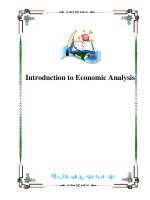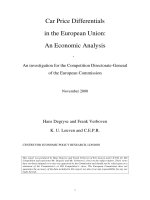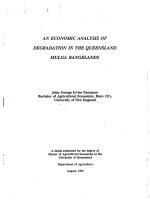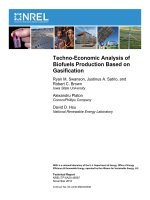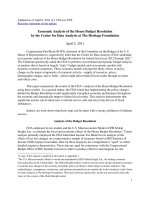Economic analysis Apply
Bạn đang xem bản rút gọn của tài liệu. Xem và tải ngay bản đầy đủ của tài liệu tại đây (991.58 KB, 31 trang )
Economic Analysis
CE 453 Lecture 37
Principal source, Wilbur Smith, et al “Guide to
the Economic Evaluation of Highway
Projects,” Iowa DOT, 1993
1
/> A systematic process for calculating and comparing benefits and
costs of a project for two purposes:
to determine if it is a sound investment (justification/feasibility)
to see how it compares with alternate projects (ranking/priority
assignment)
What You Will Find on This Website
How to define the problem that the project addresses and set up the
analysis
How to measure and value benefits and costs of transportation projects
Tools for calculating benefit-cost measures, dealing with uncertainty,
and estimating and valuing benefits and costs that do not have an
established monetary value
Benefit-cost models and links to model sites
Case studies of benefit-cost analyses for transportation projects
How to interpret and present results
References
2
Outline
Economic basis
General procedure
Estimating Costs
Estimating Benefits
Comparing costs and benefits
3
Economic Basis
A project has economic value if it increases
prosperity and incomes (is that all?)
This can happen in two ways
Increased output requires more resources (e.g.,
attracting business)
Increased efficiency (lower cost of production)
Never measured but quite important – the
reorganization of production!
Too much investment wastes resources, too little
stifles business and productivity
Economic analysis doesn’t include everything
4
5
General Procedure
Summary of chart on slide 3
1. ID project and options
2. Select base case
3. Traffic analysis and forecasts
4. Estimate capital and operations costs
5. Calculate travel efficiency cost savings
6. Calculate feasibility from user
perspective
6
General Procedure
Summary of chart on slide 3 (cont.)
7. Estimate economic development impacts
8. Calculate feasibility from economic
development perspective
9. Conduct sensitivity analysis
10. Interpret results
11. Include economic analysis with noneconomic factors in making decision
7
Estimating Costs
Capital cost
Engineer’s estimate is best (See summary of bid
prices and example plans)
Can use unit cost from experience (see example)
See list of typical elements, next page
Do not include sunk costs
Allow for a salvage (residual) value and discount it
(see next page)
8
9
Estimating Costs
Operations and maintenance cost
10
Cost Side:
Preparing
costs for B/C
11
Summary: Estimating Costs
Capital cost
Operations and maintenance cost
Preparing costs (time value) for B/C
12
Estimating Benefits
Analysis procedure
13
14
Estimating Benefits
Accident (Crash) cost savings
Years lost + direct costs
1991 cost of fatality, $2,392,742 (Urban
Institute) biased?
Willingness to pay (e.g., for a safety
improvement)
Missouri and Kansas, $1.5M (1993), Iowa,
$800,000 (2002)
15
16
17
Estimating Benefits
Travel time savings
Factors
Size of time increment saved (100%
for over 11 minutes)
Occupancy
Purpose
Willingness to pay
18
19
Estimating Benefits
Vehicle operating cost savings
Fuel, oil, maintenance, etc.
See Red book and many
references
20
Economic Development Benefits
Development principles and types
Corridor
State
Nation
Some indicators
Economic activity
Value added
Income
Employment
Population
21
Economic Development Benefits
Four categories
Construction impact
Roadside expenditures
Competitive reposition
Non-business
22
Economic Development Benefits
Economic
models
Input/output
(e.g., REMI)
23
Summary: Estimating Benefits
Accident (Crash) cost savings
Travel time savings
Auto
Truck
Vehicle operating cost savings
Economic Development Benefits
Development principles and types
Economic models
24
Comparing costs and benefits
Life cycle approach
Choose base year
Include all present and future
costs/benefits
25

